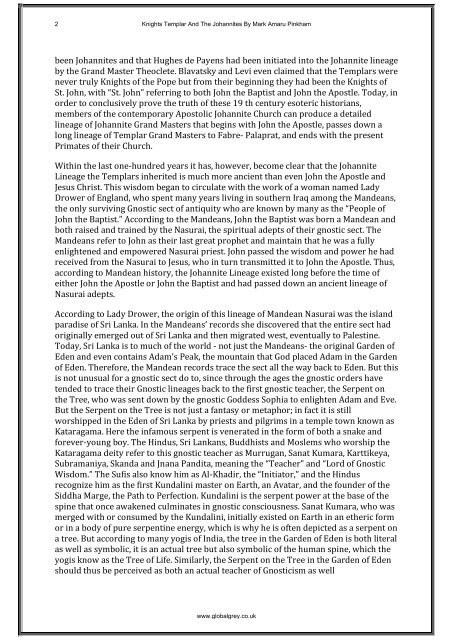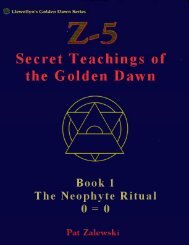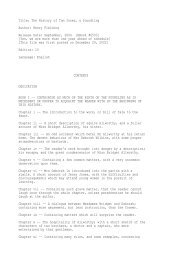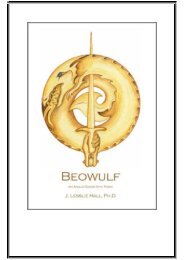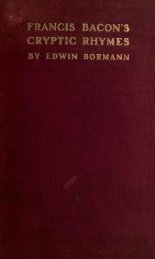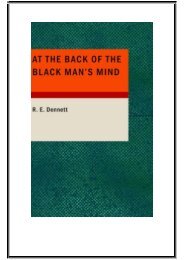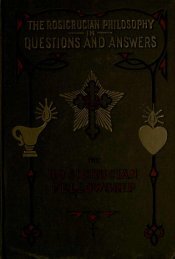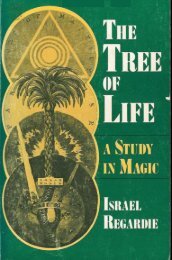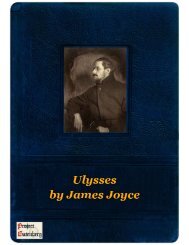download PDF version: 651KB - Global Grey
download PDF version: 651KB - Global Grey
download PDF version: 651KB - Global Grey
Create successful ePaper yourself
Turn your PDF publications into a flip-book with our unique Google optimized e-Paper software.
2 Knights Templar And The Johannites By Mark Amaru Pinkham<br />
been Johannites and that Hughes de Payens had been initiated into the Johannite lineage<br />
by the Grand Master Theoclete. Blavatsky and Levi even claimed that the Templars were<br />
never truly Knights of the Pope but from their beginning they had been the Knights of<br />
St. John, with “St. John” referring to both John the Baptist and John the Apostle. Today, in<br />
order to conclusively prove the truth of these 19 th century esoteric historians,<br />
members of the contemporary Apostolic Johannite Church can produce a detailed<br />
lineage of Johannite Grand Masters that begins with John the Apostle, passes down a<br />
long lineage of Templar Grand Masters to Fabre- Palaprat, and ends with the present<br />
Primates of their Church.<br />
Within the last one-hundred years it has, however, become clear that the Johannite<br />
Lineage the Templars inherited is much more ancient than even John the Apostle and<br />
Jesus Christ. This wisdom began to circulate with the work of a woman named Lady<br />
Drower of England, who spent many years living in southern Iraq among the Mandeans,<br />
the only surviving Gnostic sect of antiquity who are known by many as the “People of<br />
John the Baptist.” According to the Mandeans, John the Baptist was born a Mandean and<br />
both raised and trained by the Nasurai, the spiritual adepts of their gnostic sect. The<br />
Mandeans refer to John as their last great prophet and maintain that he was a fully<br />
enlightened and empowered Nasurai priest. John passed the wisdom and power he had<br />
received from the Nasurai to Jesus, who in turn transmitted it to John the Apostle. Thus,<br />
according to Mandean history, the Johannite Lineage existed long before the time of<br />
either John the Apostle or John the Baptist and had passed down an ancient lineage of<br />
Nasurai adepts.<br />
According to Lady Drower, the origin of this lineage of Mandean Nasurai was the island<br />
paradise of Sri Lanka. In the Mandeans’ records she discovered that the entire sect had<br />
originally emerged out of Sri Lanka and then migrated west, eventually to Palestine.<br />
Today, Sri Lanka is to much of the world - not just the Mandeans- the original Garden of<br />
Eden and even contains Adam’s Peak, the mountain that God placed Adam in the Garden<br />
of Eden. Therefore, the Mandean records trace the sect all the way back to Eden. But this<br />
is not unusual for a gnostic sect do to, since through the ages the gnostic orders have<br />
tended to trace their Gnostic lineages back to the first gnostic teacher, the Serpent on<br />
the Tree, who was sent down by the gnostic Goddess Sophia to enlighten Adam and Eve.<br />
But the Serpent on the Tree is not just a fantasy or metaphor; in fact it is still<br />
worshipped in the Eden of Sri Lanka by priests and pilgrims in a temple town known as<br />
Kataragama. Here the infamous serpent is venerated in the form of both a snake and<br />
forever-young boy. The Hindus, Sri Lankans, Buddhists and Moslems who worship the<br />
Kataragama deity refer to this gnostic teacher as Murrugan, Sanat Kumara, Karttikeya,<br />
Subramaniya, Skanda and Jnana Pandita, meaning the “Teacher” and “Lord of Gnostic<br />
Wisdom.” The Sufis also know him as Al-Khadir, the “Initiator,” and the Hindus<br />
recognize him as the first Kundalini master on Earth, an Avatar, and the founder of the<br />
Siddha Marge, the Path to Perfection. Kundalini is the serpent power at the base of the<br />
spine that once awakened culminates in gnostic consciousness. Sanat Kumara, who was<br />
merged with or consumed by the Kundalini, initially existed on Earth in an etheric form<br />
or in a body of pure serpentine energy, which is why he is often depicted as a serpent on<br />
a tree. But according to many yogis of India, the tree in the Garden of Eden is both literal<br />
as well as symbolic, it is an actual tree but also symbolic of the human spine, which the<br />
yogis know as the Tree of Life. Similarly, the Serpent on the Tree in the Garden of Eden<br />
should thus be perceived as both an actual teacher of Gnosticism as well<br />
www.globalgrey.co.uk


